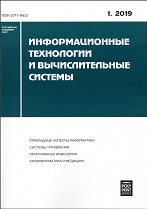|
|
Informatsionnye Tekhnologii i Vychslitel'nye Sistemy, 2015, Issue 4, Pages 13–21
(Mi itvs204)
|
 |
|
 |
Analytical models of reliability of cache memory
O. V. Mamoutova
Peter the Great St. Petersburg Polytechnic University
Abstract:
Cache memory of a processor system is highly prone to transient faults caused by radiation environment. Occurring soft errors can jeopardize the workload execution and can lead to a failure of the system. Hence the reliability analysis of preferable cache configuration is a necessary step during the design of the system. Analytical models, which use independent reference model to describe a workload, are presented as a tool for fast estimation of reliability. Models cover cases of cache without any reliability improvements, cache with error correcting codes with and without error recovery, and cache with scrubbing. A vulnerability factor is defined as a measure of reliability. Input data for the models are cache size, block length, write operation rate, miss rate distribution, error occurrence rate, and memory hierarchy access time. Conducted analysis confirmed, that self-recovery effects in cache memory can not provide enough reliability and should be complemented with additional reliability improvement. Also, it is shown, that in most cases the value of vulnerability factor does not depend on observation period of analysis, but only on the size of cache memory. As a whole, presented analytical approach allows to get a detailed analysis of reliability opposed to traditional statistical modeling.
Keywords:
reliability, processor, cache, SEU, analytical model, workload, vulnerability, scrubbing, ECC, cache size, error, recovery, masking.
Citation:
O. V. Mamoutova, “Analytical models of reliability of cache memory”, Informatsionnye Tekhnologii i Vychslitel'nye Sistemy, 2015, no. 4, 13–21
Linking options:
https://www.mathnet.ru/eng/itvs204 https://www.mathnet.ru/eng/itvs/y2015/i4/p13
|

| Statistics & downloads: |
| Abstract page: | 68 | | Full-text PDF : | 79 | | References: | 1 |
|




 Contact us:
Contact us: Terms of Use
Terms of Use
 Registration to the website
Registration to the website Logotypes
Logotypes









 Citation in format
Citation in format 